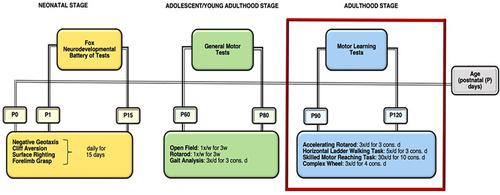当前位置:
X-MOL 学术
›
Genes Brain Behav.
›
论文详情
Our official English website, www.x-mol.net, welcomes your feedback! (Note: you will need to create a separate account there.)
Developmental coordination disorder: What can we learn from RI mice using motor learning tasks and QTL analysis
Genes, Brain and Behavior ( IF 2.5 ) Pub Date : 2023-08-08 , DOI: 10.1111/gbb.12859 Kamaldeep Gill 1, 2 , Jeffy Rajan Soundara Rajan 3, 4 , Eric Chow 2, 4 , David G Ashbrook 5 , Robert W Williams 5 , Jill G Zwicker 2, 6, 7 , Daniel Goldowitz 2, 3, 4
Genes, Brain and Behavior ( IF 2.5 ) Pub Date : 2023-08-08 , DOI: 10.1111/gbb.12859 Kamaldeep Gill 1, 2 , Jeffy Rajan Soundara Rajan 3, 4 , Eric Chow 2, 4 , David G Ashbrook 5 , Robert W Williams 5 , Jill G Zwicker 2, 6, 7 , Daniel Goldowitz 2, 3, 4
Affiliation

|
Developmental Coordination Disorder (DCD) is a neurodevelopmental disorder of unknown etiology that affects one in 20 children. There is an indication that DCD has an underlying genetic component due to its high heritability. Therefore, we explored the use of a recombinant inbred family of mice known as the BXD panel to understand the genetic basis of complex traits (i.e., motor learning) through identification of quantitative trait loci (QTLs). The overall aim of this study was to utilize the QTL approach to evaluate the genome-to-phenome correlation in BXD strains of mice in order to better understand the human presentation of DCD. Results of this current study confirm differences in motor learning in selected BXD strains and strains with altered cerebellar volume. Five strains – BXD15, BXD27, BXD28, BXD75, and BXD86 – exhibited the most DCD-like phenotype when compared with other BXD strains of interest. Results indicate that BXD15 and BXD75 struggled primarily with gross motor skills, BXD28 primarily had difficulties with fine motor skills, and BXD27 and BXD86 strains struggled with both fine and gross motor skills. The functional roles of genes within significant QTLs were assessed in relation to DCD-like behavior. Only Rab3a (Ras-related protein Rab-3A) emerged as a high likelihood candidate gene for the horizontal ladder rung task. This gene is associated with brain and skeletal muscle development, but lacked nonsynonymous polymorphisms. This study along with Gill et al. (same issue) is the first studies to specifically examine the genetic linkage of DCD using BXD strains of mice.
中文翻译:

发育协调障碍:我们可以通过运动学习任务和 QTL 分析从 RI 小鼠身上学到什么
发育协调障碍 (DCD) 是一种病因不明的神经发育障碍,每 20 名儿童中就有一人受到影响。有迹象表明,DCD 由于其高遗传力而具有潜在的遗传成分。因此,我们探索使用称为 BXD panel 的重组小鼠近交家族,通过鉴定数量性状基因座 (QTL) 来了解复杂性状(即运动学习)的遗传基础。本研究的总体目标是利用 QTL 方法评估 BXD 小鼠品系的基因组与表型组的相关性,以便更好地了解 DCD 的人类表现。本研究的结果证实了选定的 BXD 品系和小脑体积改变的品系在运动学习方面的差异。与其他感兴趣的 BXD 菌株相比,五种菌株(BXD15、BXD27、BXD28、BXD75 和 BXD86)表现出最类似 DCD 的表型。结果表明,BXD15 和 BXD75 主要在粗大运动技能方面存在困难,BXD28 主要在精细运动技能方面存在困难,BXD27 和 BXD86 品系在精细运动技能和粗大运动技能方面均存在困难。重要 QTL 内基因的功能作用与 DCD 样行为相关进行评估。只有Rab3a(Ras 相关蛋白 Rab-3A)成为水平梯级任务的高可能性候选基因。该基因与大脑和骨骼肌发育相关,但缺乏非同义多态性。这项研究与吉尔等人一起进行。(同一期)是第一个使用 BXD 品系小鼠专门检查 DCD 遗传连锁的研究。
更新日期:2023-08-08
中文翻译:

发育协调障碍:我们可以通过运动学习任务和 QTL 分析从 RI 小鼠身上学到什么
发育协调障碍 (DCD) 是一种病因不明的神经发育障碍,每 20 名儿童中就有一人受到影响。有迹象表明,DCD 由于其高遗传力而具有潜在的遗传成分。因此,我们探索使用称为 BXD panel 的重组小鼠近交家族,通过鉴定数量性状基因座 (QTL) 来了解复杂性状(即运动学习)的遗传基础。本研究的总体目标是利用 QTL 方法评估 BXD 小鼠品系的基因组与表型组的相关性,以便更好地了解 DCD 的人类表现。本研究的结果证实了选定的 BXD 品系和小脑体积改变的品系在运动学习方面的差异。与其他感兴趣的 BXD 菌株相比,五种菌株(BXD15、BXD27、BXD28、BXD75 和 BXD86)表现出最类似 DCD 的表型。结果表明,BXD15 和 BXD75 主要在粗大运动技能方面存在困难,BXD28 主要在精细运动技能方面存在困难,BXD27 和 BXD86 品系在精细运动技能和粗大运动技能方面均存在困难。重要 QTL 内基因的功能作用与 DCD 样行为相关进行评估。只有Rab3a(Ras 相关蛋白 Rab-3A)成为水平梯级任务的高可能性候选基因。该基因与大脑和骨骼肌发育相关,但缺乏非同义多态性。这项研究与吉尔等人一起进行。(同一期)是第一个使用 BXD 品系小鼠专门检查 DCD 遗传连锁的研究。



























 京公网安备 11010802027423号
京公网安备 11010802027423号